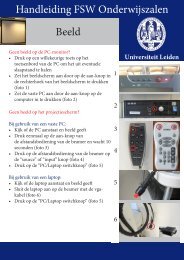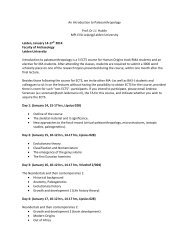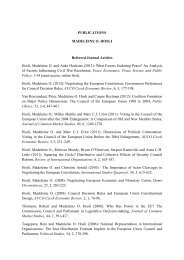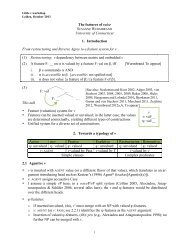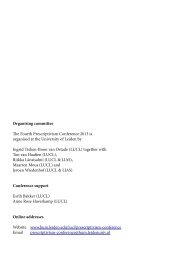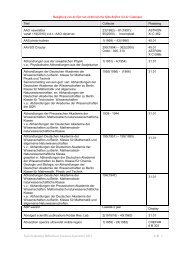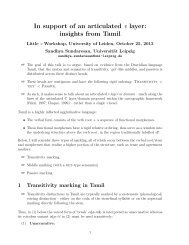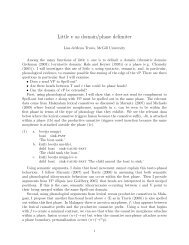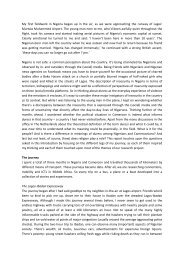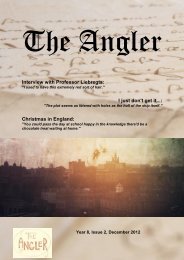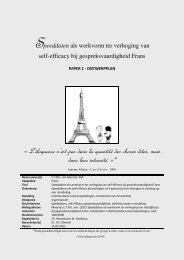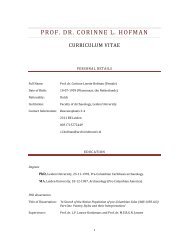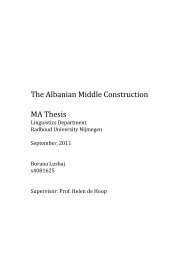Institute for History Annual Report 2010 - O - Universiteit Leiden
Institute for History Annual Report 2010 - O - Universiteit Leiden
Institute for History Annual Report 2010 - O - Universiteit Leiden
You also want an ePaper? Increase the reach of your titles
YUMPU automatically turns print PDFs into web optimized ePapers that Google loves.
ondly by in depth case studies to view the precise<br />
iconographical changes in the illustrations. Focus<br />
points are the shift in techniques from manuscript<br />
to print and the choices that have been made <strong>for</strong><br />
that, the choice of texts and images by the printers,<br />
and the reactions of the intended reading public.<br />
Project: Twilight zone: party strife,<br />
factionalism, and feuding in the Northern<br />
Low Countries.<br />
Peter Hoppenbrouwers<br />
During the final centuries of the Middle Ages the<br />
Low Countries were ridden by violent clashes<br />
between what contemporary sources called partes<br />
(Middle Dutch: partien/pertien), a word that may be<br />
translated as parties or factions, dependent on the<br />
extent of their goals, recruitment and activities.<br />
Exactly this ambiguous setting, in a twilight zone<br />
between the supra-local and the local, as well as<br />
between a ‘public’/political and a ‘private’/familial<br />
field of action, makes party strife and factionalism<br />
attractive subjects of innovative historical research,<br />
that can contribute to a better understanding of the<br />
often neglected counterweights that were build-up<br />
against the slow but relentless rise of the modern<br />
state in Western Europe during the late medieval<br />
and early modern periods. This project’s aim is to<br />
increase our knowledge of party strife and<br />
factionalism substantially along two tracks: by<br />
extending existing knowledge geographically and<br />
thematically, and by looking <strong>for</strong> completely new<br />
angles that join in with international research. In<br />
this particular case the theme of party strife and<br />
faction quarrels will be linked to four phenomena<br />
<strong>Institute</strong> <strong>for</strong> <strong>History</strong><br />
53<br />
that are generally considered to have been typical<br />
<strong>for</strong> dealing with political tension in later medieval<br />
society: feuding, bastard feudalism, the creation of<br />
bargaining networks, and popular revolts. The<br />
project consists of three subprojects, in which three<br />
quite different variations on the theme of party<br />
strife and factionalism are developed <strong>for</strong> the last<br />
three territories in the Northern Low Countries to<br />
be <strong>for</strong>mally incorporated into the Burgundian-<br />
Habsburg empire: (prince less) Friesland West of<br />
the Lauwers, the Prince-bishopric of Utrecht, and<br />
the Duchy of Guelders.<br />
Hollanders as ‘the Other’. Late medieval<br />
perceptions of identity in Hanseatic<br />
sources (Rubicon project)<br />
Justyna Wubs-Mrozewicz<br />
The division between ‘us’ and ‘them’ is one of the<br />
most common mechanisms of social interaction<br />
and (self)perception. It also contributes to the<br />
creation of identities, both nowadays and in the<br />
past. In this project, Hollanders in the late Middle<br />
Ages are viewed as ‘the Other’ through the lens of<br />
Hanseatic sources. Hollanders were an upcoming<br />
mercantile power in the 15th-16th centuries,<br />
expanding to the Baltic region: a ground until then<br />
dominated by the Hanse, a mercantile<br />
organisation. The interaction with Hanseatic<br />
traders ranged from rivalry to cooperation, and it<br />
resulted in the creation of an image of Hollanders<br />
as ‘the Other’. There are abundant sources on this<br />
representation of Hollanders, and it is one of the<br />
few instances when an external view on the<br />
medieval Hollandish identity can be analysed.



